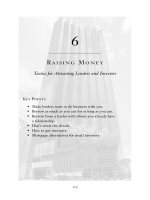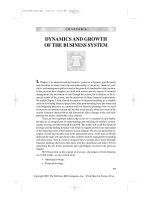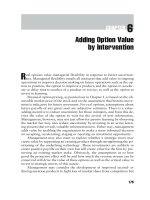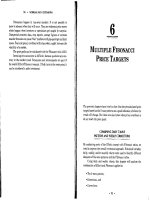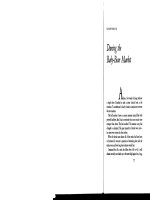Chapter 6 fixed assets
Bạn đang xem bản rút gọn của tài liệu. Xem và tải ngay bản đầy đủ của tài liệu tại đây (376.87 KB, 30 trang )
OPEN UNIVERSITY HCMC
MBA PREPARATORY COURSE
Principles of Financial
Accounting
06/04/16
NGUYEN TAN BINH - PHAN DUC DUNG
1
Chapter 6
Long-Lived Assets
and Depreciation
06/04/16
NGUYEN TAN BINH - PH
2
Learning Objectives
After studying this chapter, you should be able to:
Measure the acquisition cost of tangible assets
such as land, buildings, and equipment.
Compute depreciation for buildings and
equipment using various depreciation methods.
Differentiate financial statement depreciation
from income tax depreciation.
Explain depreciation’s effects on cash flow.
06/04/16
NGUYEN TAN BINH - PH
3
Learning Objectives
After studying this chapter, you
should be able to:
Distinguish expenses from expenditures
that should be capitalized.
Compute gains and losses on disposal
of fixed assets.
Interpret depletion of natural resources.
Account for various intangible assets.
06/04/16
NGUYEN TAN BINH - PH
4
Overview of Long-Lived Assets
Long-lived assets - resources that are
held for an extended time, such as
land, buildings, equipment, natural
resources, and patents
These assets help produce revenues over
many periods
by facilitating the
production and sale of goods
or services to customers.
06/04/16
NGUYEN TAN BINH - PH
5
Overview of Long-Lived Assets
Tangible assets - physical items that can be
seen and touched, such as land, natural
resources, buildings, and equipment
Also known as fixed assets or plant assets
Intangible assets - rights or economic
benefits, such as franchises, patents,
trademarks, copyrights, and goodwill that
are not physical in nature
06/04/16
NGUYEN TAN BINH - PH
6
Overview of Long-Lived Assets
Terms for allocation of costs over time:
Depreciation - allocation of the cost of tangible assets
to the periods in which the assets are used
Depletion - allocation of the cost of natural resources
to the periods in which the resources are used
Amortization - allocation of the cost of intangible
assets to the periods that benefit from these assets
Land is not depreciated because it does not wear out or
become obsolete.
06/04/16
NGUYEN TAN BINH - PH
7
Acquisition Cost of
Tangible Assets
The acquisition cost of long-lived assets
is the purchase price, including
incidental costs required to complete
the purchase, to transport the asset,
and to prepare it for use.
06/04/16
NGUYEN TAN BINH - PH
8
Acquisition Cost of
Tangible Assets
Land
The acquisition cost of land includes costs of
land surveys, legal fees, title fees, realtor
commissions, transfer taxes, and the demolition
costs of old structures.
Under historical cost accounting, land is carried
on the balance sheet at its original cost even if
the market value of the land is many times that
of the original cost.
06/04/16
NGUYEN TAN BINH - PH
9
Acquisition Cost of
Tangible Assets
Buildings and Equipment
Costs should include all costs of acquisition
and preparation for use, such as sales
taxes, transportation costs, installation
costs, and repairs to the asset prior to use.
Costs included in the cost of an asset are
capitalized (added to the asset account), as
distinguished from being expensed
immediately.
06/04/16
NGUYEN TAN BINH - PH
10
Depreciation of Buildings
and Equipment
Depreciation in the accounting sense is not a process of
valuation.
Depreciation is a form of allocating the cost of an
asset to periods when the asset is used.
Depreciation is one key factor that distinguishes accrual
accounting from cash-basis accounting.
Under the accrual basis, the cost of the asset is
allocated to the periods benefited.
Under the cash basis, the cost of the asset would be
expensed immediately.
06/04/16
NGUYEN TAN BINH - PH
11
Depreciation of Buildings
and Equipment
Depreciable value - the amount of acquisition cost
to be allocated as depreciation over the total useful
life of an asset
The depreciable value is the difference between
the acquisition cost and the predicted residual
value.
Residual value - the amount received from disposal
of a long-lived asset at the end of its useful life
06/04/16
NGUYEN TAN BINH - PH
12
Depreciation of Buildings
and Equipment
Useful life (economic life) - the time
period over which an asset is depreciated
The useful life is the shorter of the physical life
of the asset before it wears out or the
economic life of the asset before it becomes
obsolete.
The useful life can be measured in terms other
than time. For example, the life of a truck can
be measured in miles
driven.
06/04/16
NGUYEN TAN BINH - PH
13
Straight-Line Depreciation
Straight-line depreciation - a
method that spreads the depreciable
value evenly over the useful life of an
asset
Depreciation = Acquisition cost - Residual value
expense
Years of useful life
06/04/16
NGUYEN TAN BINH - PH
14
Straight-Line Depreciation
A truck with a cost of $41,000 and a
residual value of $1,000 has a useful
life of 4 years. Depreciation expense is
calculated as follows:
($41,000 - $1,000) / 4 = $10,000*
*Depreciation is the same each year for the life of
the asset.
06/04/16
NGUYEN TAN BINH - PH
15
Depreciation Based on Units
Unit depreciation - a depreciation method
based on units of service when physical wear
and tear is the dominating influence on the
useful life of the asset
A depreciation rate per unit is determined by
dividing the depreciable value (cost less residual
value) by the useful life in units.
To determine depreciation expense, the actual
usage of the asset is multiplied by the
depreciation rate.
06/04/16
NGUYEN TAN BINH - PH
16
Depreciation Based on Units
A truck with a cost of $41,000 and a
residual value of $1,000 has a useful life of
200,000 miles. During the year, the truck is
driven for 45,000 miles. Depreciation
expense is calculated as follows:
($41,000 - $1,000)/200,000 = $.20 per mile
45,000 x $.20 = $9,000*
*Depreciation over the life of the asset will fluctuate as
the usage of the asset fluctuates.
06/04/16
NGUYEN TAN BINH - PH
17
Declining-Balance
Depreciation
Accelerated depreciation - any depreciation method
that writes off depreciable costs more quickly than the
ordinary straight-line method based on expected useful
life
Double-declining-balance (DDB) depreciation - the
most popular form of accelerated depreciation
It is computed by doubling the straight-line
rate and multiplying the resulting DDB rate by
the beginning book value.
06/04/16
NGUYEN TAN BINH - PH
18
Declining-Balance
Depreciation
Computing DDB depreciation:
Compute a rate by dividing 100% by the
number of years of useful life.
Double the rate.
Ignore the residual value, and multiply the
asset’s book value at the beginning of the
year by the DDB rate.
06/04/16
Stop depreciation when the book value
reaches the residual value.
NGUYEN TAN BINH - PH
19
Declining-Balance
Depreciation
A truck with a cost of $41,000 and a residual
value of $1,000 has a useful life of 4 years.
Double-declining-balance depreciation expense
is calculated as follows:
100% / 4 = 25% x 2 = 50% per year
Year 1: $41,000 x 50% = $20,500*
Year 2: ($41,000 - $20,500) x 50% = $10,250*
*Depreciation over the life of the asset declines each year.
06/04/16
NGUYEN TAN BINH - PH
20
Comparing and Choosing
Depreciation Methods
Straight-line gives the same depreciation
expense each year of the useful life of the
asset.
DDB gives accelerated depreciation expense
(more than regular straight-line) in the first
years of the useful life of the asset.
Companies will often switch from DDB to
straight-line part way through the life of
the asset to compensate for the fact the
DDB may not fully depreciate the asset.
06/04/16
NGUYEN TAN BINH - PH
21
Comparing and Choosing
Depreciation Methods
Companies do not always use the same depreciation
methods for all types of depreciable assets.
The choice of depreciation alternatives comes from
several places:
Tradition or use by other companies in the
industry
Better matching of expenses with revenues
The nature of the industry and the equipment
and the goals of management
06/04/16
NGUYEN TAN BINH - PH
22
Depreciation and Cash Flow
Depreciation does not generate cash.
Depreciation allocates the original cost of
an asset to the periods when the asset is
used.
Accumulated depreciation is merely the
total amount that an asset has been
depreciated throughout its life.
06/04/16
NGUYEN TAN BINH - PH
23
Effects of Depreciation on
Cash
Depreciation has no effect on ending cash
balances because it is a noncash expense.
Before taxes, changes in the depreciation
method affect only the Accumulated
Depreciation and Retained Earnings
accounts.
06/04/16
NGUYEN TAN BINH - PH
24
Effects of Depreciation on
Income Taxes
Depreciation is a deductible noncash expense for income
tax purposes.
If depreciation expense is higher, taxes are
lower, and more cash can be kept for use in
the business.
Accelerated depreciation generally has higher
depreciation expense.
Depreciation does not generate cash, but it does have a
cash benefit if it results in lower taxes.
06/04/16
NGUYEN TAN BINH - PH
25



